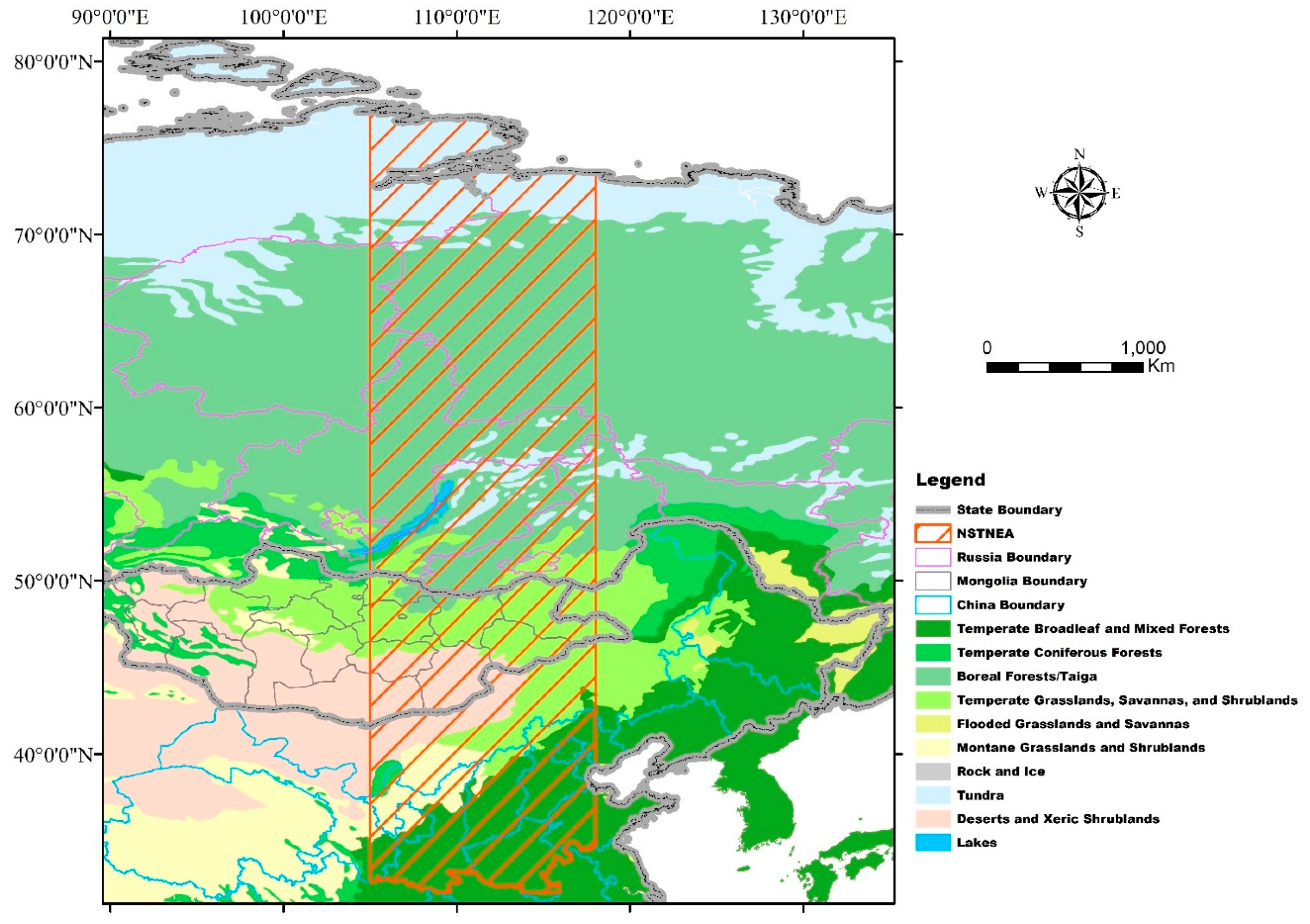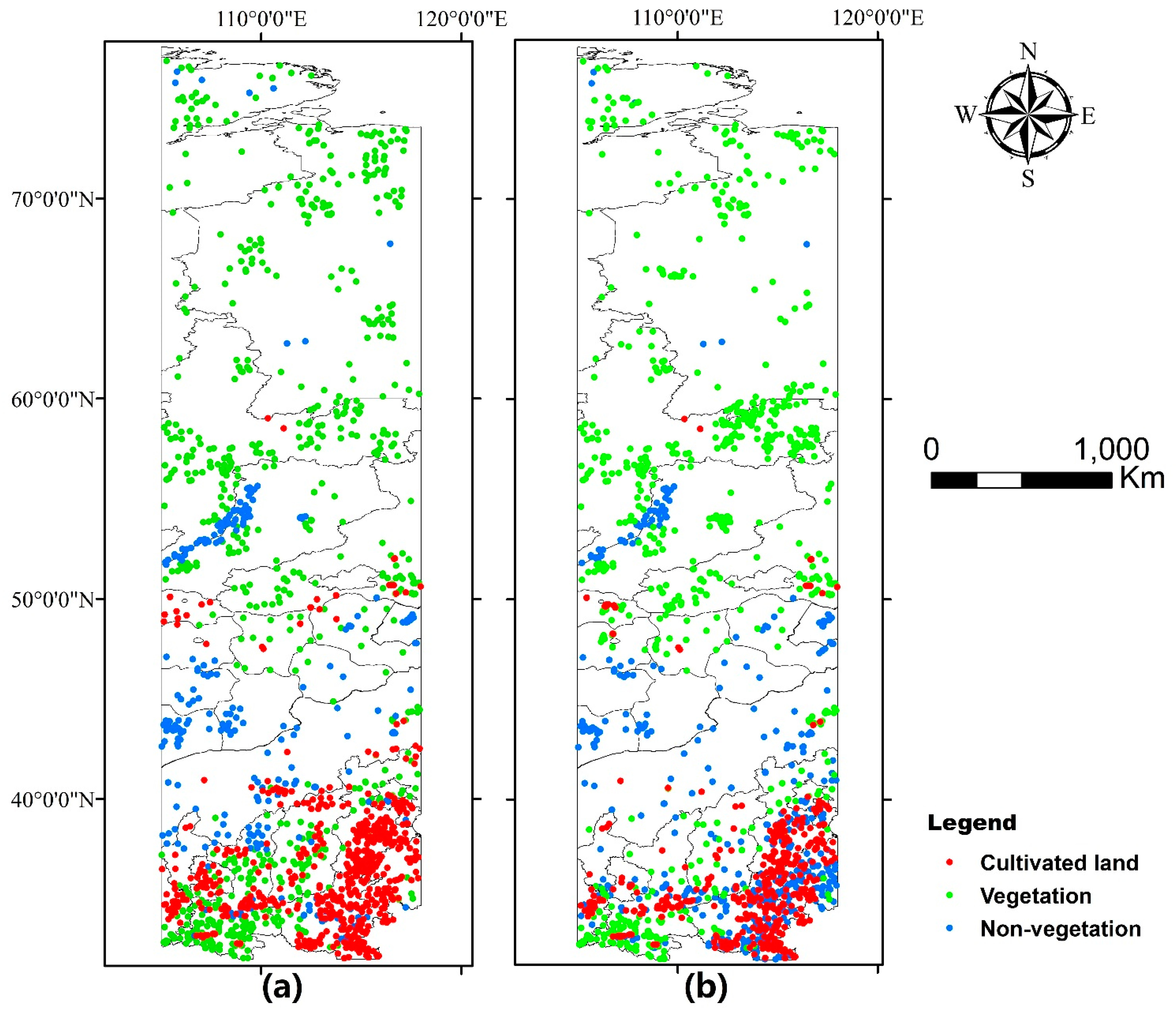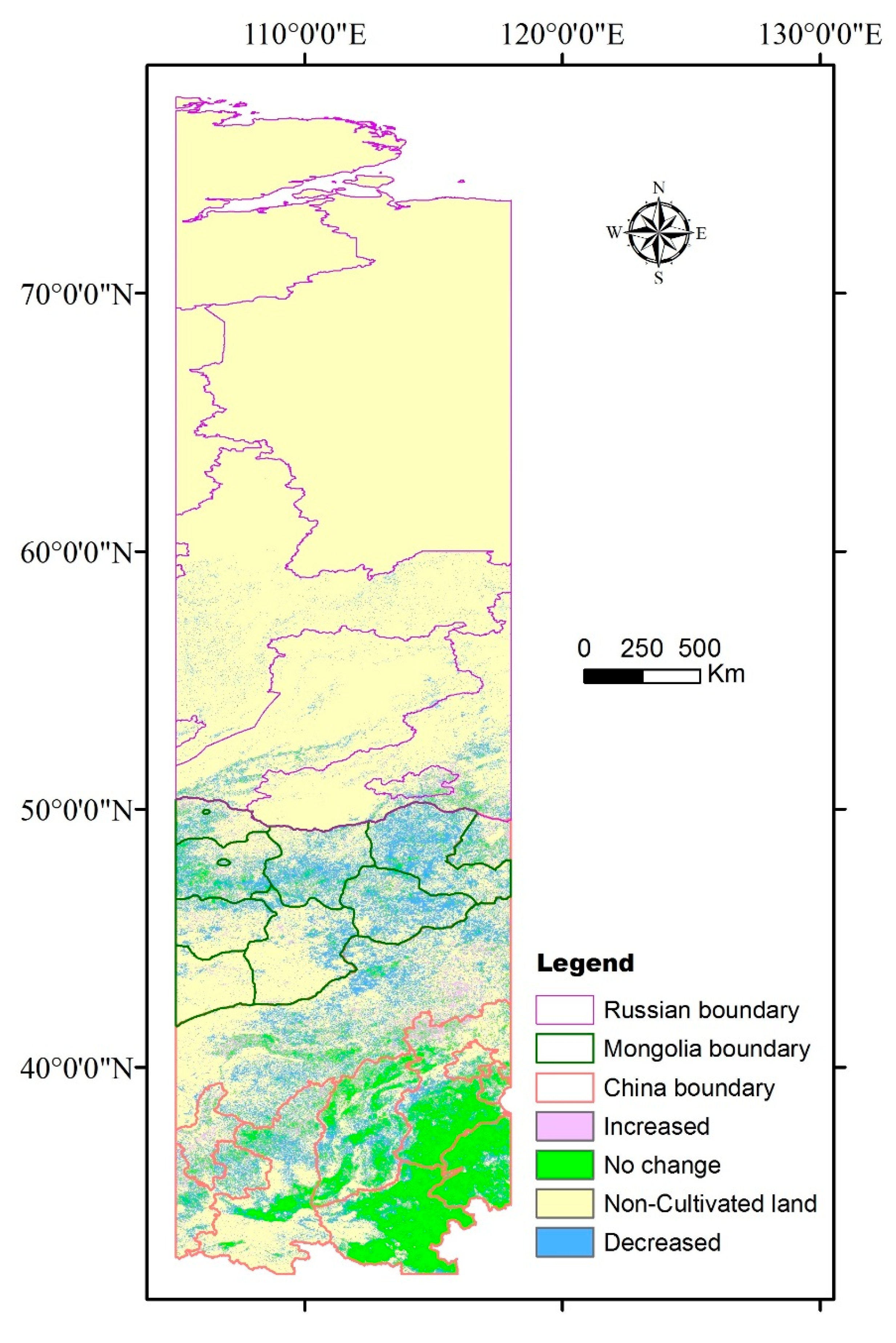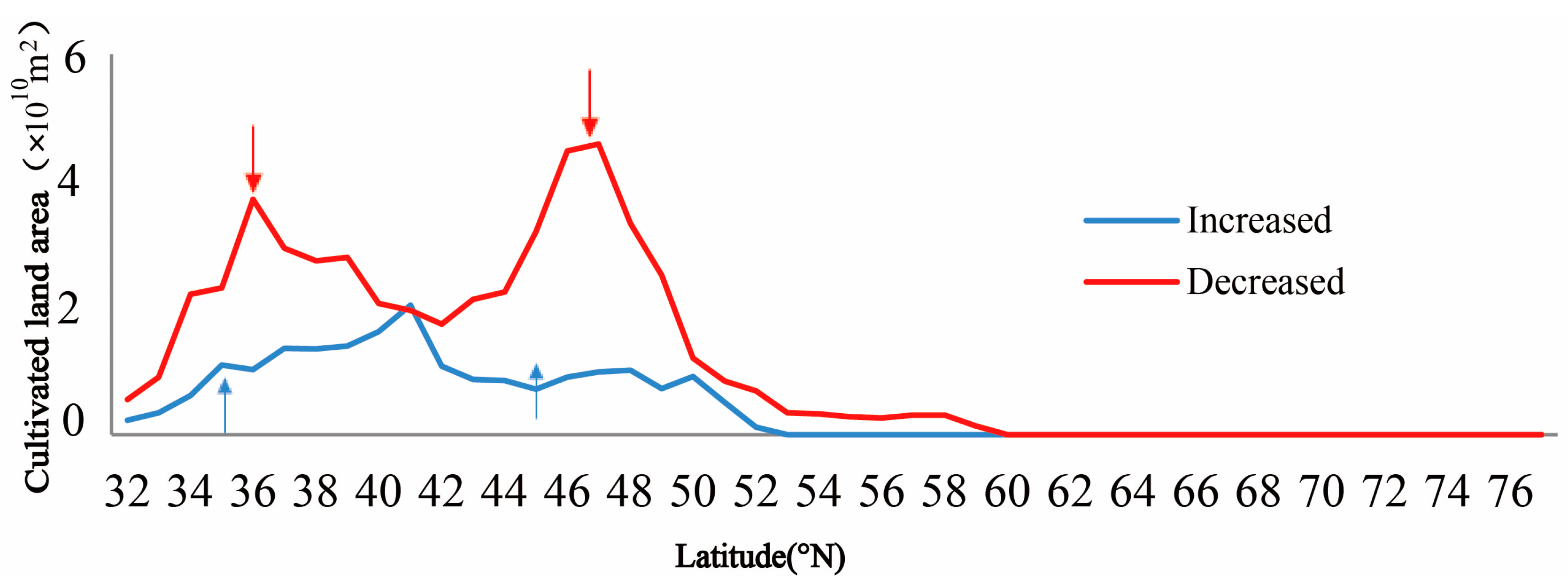Cultivated Land Information Extraction and Gradient Analysis for a North-South Transect in Northeast Asia between 2000 and 2010
Abstract
:1. Introduction
2. Materials and Methodology
2.1. Study Area and Data
2.1.1. Study Area

2.1.2. Data
| Data Sets Name | Brief Description |
|---|---|
| 250m_16_days_NDVI | Normalized Difference Vegetation Index |
| 250m_16_days_EVI | Enhanced Vegetation Index |
| 250m_16_days_VI_Quality | Vegetation Index Quality |
| 250m_16_days_red_reflectance | Red Reflectance |
| 250m_16_days_NIR_reflectance | NIR Reflectance |
| 250m_16_days_blue_reflectance | Blue Reflectance |
| 250m_16_days_MIR_reflectance | MIR Reflectance |
| 250m_16_days_view_zenith_angle | View Zenith Angle |
| 250m_16_days_sun_zenith_angle | Sun Zenith Angle |
| 250m_16_days_relative_azimuth_angle | Relative Zenith Angle |
| 250m_16_days_composite_day_of_the_year | Composite Day of the Year |
| 250m_16_days_pixel_reliability | Pixel Reliability Summary Quality |
| Day in 2000 | Day in 2010 | Temporal Serial |
|---|---|---|
| 2000049 | 2010049 | T1 |
| 2000065 | 2010065 | T2 |
| 2000081 | 2010081 | T3 |
| 2000097 | 2010097 | T4 |
| 2000113 | 2010113 | T5 |
| 2000129 | 2010129 | T6 |
| 2000145 | 2010145 | T7 |
| 2000161 | 2010161 | T8 |
| 2000177 | 2010177 | T9 |
| 2000193 | 2010193 | T10 |
| 2000209 | 2010209 | T11 |
| 2000225 | 2010225 | T12 |
| 2000241 | 2010241 | T13 |
| 2000257 | 2010257 | T14 |
| 2000273 | 2010273 | T15 |
| 2000289 | 2010289 | T16 |
| 2010305 | ---------- | T17 |
| 2010321 | ---------- | T18 |
2.2. Methodology
2.2.1. Harmonic Analysis of Time Series
2.2.2. Multiple Endmembers Spectral Mixture Analysis

2.2.4. Accuracy Assessment Method
3. Results
3.1. Time Series Data Reconstruction


3.2. Cultivated Land Information Extraction


3.3. Accuracy Assessment
3.3.1. Model Accuracy
(1) Model Accuracy Assessment in 2000
| Range (%) | T1 | T2 | T3 | T4 | T5 | T6 | T7 | T8 | T9 |
|---|---|---|---|---|---|---|---|---|---|
| 0–0.1 | 99.549 | 99.528 | 99.4776 | 99.4572 | 99.4821 | 99.4865 | 99.5076 | 99.5684 | 99.5913 |
| 0.1–0.2 | 0.3979 | 0.4118 | 0.449 | 0.4583 | 0.4367 | 0.4417 | 0.4432 | 0.3881 | 0.3653 |
| 0.2–0.3 | 0.0405 | 0.0422 | 0.0494 | 0.0589 | 0.0552 | 0.0544 | 0.0402 | 0.0358 | 0.0364 |
| 0.3–0.4 | 0.0057 | 0.0102 | 0.0119 | 0.0129 | 0.0147 | 0.0122 | 0.007 | 0.0065 | 0.0048 |
| 0.4–0.5 | 0.0015 | 0.0036 | 0.0062 | 0.0063 | 0.0062 | 0.0033 | 0.0008 | 0.0008 | 0.0019 |
| >0.5 | 0.0031 | 0.0044 | 0.006 | 0.0062 | 0.0039 | 0.0009 | 0 | 0 | 0.0002 |
| Range (%) | T10 | T11 | T12 | T13 | T14 | T15 | T16 | T17 | T18 |
| 0–0.1 | 99.591 | 99.6 | 99.6755 | 99.6502 | 99.5461 | 99.3934 | 99.3622 | 99.4751 | 99.6236 |
| 0.1–0.2 | 0.3587 | 0.3597 | 0.2957 | 0.3185 | 0.4022 | 0.5138 | 0.5231 | 0.443 | 0.3176 |
| 0.2–0.3 | 0.0434 | 0.0365 | 0.0244 | 0.026 | 0.0402 | 0.0758 | 0.093 | 0.0621 | 0.042 |
| 0.3–0.4 | 0.005 | 0.0041 | 0.0037 | 0.0037 | 0.0088 | 0.0128 | 0.0176 | 0.0128 | 0.0102 |
| 0.4–0.5 | 0.0018 | 0.0002 | 0.0003 | 0.0008 | 0.0022 | 0.003 | 0.0029 | 0.0037 | 0.0024 |
| >0.5 | 0 | 0 | 0 | 0 | 0.0004 | 0.0008 | 0.0011 | 0.0038 | 0.0045 |
| Range | 0–0.05 | 0.05–0.1 | 0.1–0.15 | 0.15–0.2 | 0.2–0.25 | 0.25–0.3 | 0.3–0.35 | >0.35 |
|---|---|---|---|---|---|---|---|---|
| Percent % | 98.1176 | 1.5012 | 0.275 | 0.0693 | 0.0191 | 0.0085 | 0.0037 | 0.0051 |
(2) Model Accuracy Assessment in 2010
| Range (%) | T1 | T2 | T3 | T4 | T5 | T6 | T7 | T8 |
|---|---|---|---|---|---|---|---|---|
| 0–0.1 | 99.46 | 99.5605 | 99.5399 | 99.5799 | 99.4923 | 99.3838 | 99.4252 | 99.5847 |
| 0.1–0.2 | 0.3974 | 0.3881 | 0.4235 | 0.379 | 0.4466 | 0.569 | 0.5283 | 0.386 |
| 0.2–0.3 | 0.0283 | 0.0389 | 0.0285 | 0.0318 | 0.0515 | 0.0396 | 0.0435 | 0.0261 |
| 0.3–0.4 | 0.0097 | 0.0078 | 0.006 | 0.0074 | 0.008 | 0.0058 | 0.0025 | 0.0024 |
| 0.4–0.5 | 0.0047 | 0.0026 | 0.0012 | 0.0011 | 0.001 | 0.0011 | 0 | 0.0001 |
| >0.5 | 0.0072 | 0.0042 | 0.0012 | 0.0011 | 0.001 | 0.0011 | 0 | 0.0001 |
| Range (%) | T9 | T10 | T11 | T12 | T13 | T14 | T15 | T16 |
| 0–0.1 | 99.661 | 99.661 | 99.6472 | 99.6798 | 99.5968 | 99.4373 | 99.4275 | 99.4788 |
| 0.1–0.2 | 0.3092 | 0.3092 | 0.3339 | 0.2987 | 0.3656 | 0.5122 | 0.5099 | 0.4606 |
| 0.2–0.3 | 0.0262 | 0.0262 | 0.0143 | 0.0174 | 0.0343 | 0.0436 | 0.0493 | 0.0433 |
| 0.3–0.4 | 0.0025 | 0.0025 | 0.0035 | 0.0034 | 0.0026 | 0.006 | 0.0097 | 0.0109 |
| 0.4–0.5 | 0.0002 | 0.0002 | 0.0005 | 0 | 0 | 0.0006 | 0.0023 | 0.0042 |
| >0.5 | 0.0002 | 0.0002 | 0.0005 | 0 | 0 | 0.0006 | 0.0025 | 0.0057 |
| Range | 0–0.05 | 0.05–0.1 | 0.1–0.15 | 0.15–0.2 | 0.2–0.25 | 0.25–0.3 | 0.3–0.35 | >0.35 |
|---|---|---|---|---|---|---|---|---|
| Percent % | 98.1176 | 1.5012 | 0.275 | 0.0693 | 0.0191 | 0.0085 | 0.0018 | 0 |
3.3.2 Cultivated Land Accuracy
| GLC2000 | GlobCover2009 | NLCD-2000 | |
|---|---|---|---|
| Overall Accuracy | 72.81% | 83.16% | 94.76% |
| Spatial Consistency Coefficient | 0.78 | 0.75 | 0.79 |
4. Discussion
4.1. Spatial Distribution Analysis

4.2. Gradient Analysis


4.3. Analysis of the Driving Forces Changing the Cultivated Land
5. Conclusions
Acknowledgments
Author Contributions
Conflicts of Interest
References
- Wang, J.-L.; Song, J.; Zhu, L.-J. Construcion of resource and environment science expedition data resource integration system in Northeast Asia. J. Geoinf. Sci. 2012, 14, 74–80. [Google Scholar]
- Wang, J.-L.; Zhu, L.-J.; Sun, C.L. Study and implementation on multi dimension data management model in integrated resources and environment scientific expedition—Case in integrated scientific expedition in North China and its neighboring area. J. Nat. Res. 2011, 26, 1129–1138. [Google Scholar]
- Wang, J.-L.; Zhu, L.-J.; Yang, Y.; Zhang, L. Design, development and application of Northeast Asia resources and environment scientific expedition data platform. J. Resour. Ecol. 2011, 2, 266–271. [Google Scholar]
- Deng, J.-S.; Wang, K.; Shen, Z.-Q.; Xu, H.-W. Decision tree algorithm of automatically extracting farmland information from SPOT-5 images based on characteristic bands. Trans. Chin. Soc. Agric. Eng. 2004, 20, 145–148. [Google Scholar]
- Stern, A.J.; Doraiswamy, P.C.; Akhmedov, B. Techniques for developing land-use classification using moderate resolution imaging spectroradiometer imagery. J. Appl. Remote Sens. 2009, 3. [Google Scholar] [CrossRef]
- Li, X.-C.; Xu, X.-G.; Wang, J.-H.; Wu, H.-F.; Jing, X.-L.; Li, C.-J.; Bao, Y.-S. Crop classification recognition based on time-series images from HJ satellite. Trans. Chin. Soc. Agric. Eng. 2013, 29, 169–176. (In Chinese) [Google Scholar]
- Hou, G.-L.; Zhang, H.-Y.; Wang, Y.-Q.; Zhang, Z.-X. Application of harmonic analysis of time series to extracting the cropland resource in Northeast China. J. Nat. Res. 2010, 9, 1607–1617. [Google Scholar]
- Wang, H.-S. Arable Land Information Extraction Using MODIS Multi-Temporal Data. Ph.D. Thesis, Zhejiang University, China, 2008. [Google Scholar]
- Bai, M.; Liu, H; Huang, W.; Qiao, Y.; Mu, X. Automatic farmland extraction from multi-temporal Landsat TM data based on artificial neural network. In Proceedings of 2009 Inernational Conference on Geoinformatics, Fairfax, VA, USA, 12–14 August 2009; pp. 1–4.
- Bruzzone, L.; Cossu, R. A multiple-cascade-classifier system for a robust and partially unsupervised updating of land-cover maps. IEEE Trans. Geosci. Remote Sens. 2002, 40, 1984–1996. [Google Scholar] [CrossRef]
- Liu, X.-S.; Sun, R.; Wu, F.; Hu, B.; Wang, W. Land-cover classification for Henan Province with time-series MODIS EVI data. Trans. Chin. Soc. Agric. Eng. 2010, 26, 213–219. (In Chinese) [Google Scholar]
- Tang, Y.; Yang, W.-N.; Li, J.; Dai, X.-A. A study of information extraction based on QuickBird data—Taking the extraction of cultivated land for an example. In Proceedings of 2010 International Conference on Multimedia Technology (ICMT), Ningbo, China, 29–31 October 2010; pp. 1–4.
- Zhu, L.; Wu, B.-F.; Zhou, Y.-M.; Zhang, L.; Zhang, N. Object-oriented land cover information extraction in emigration area of Zigui county using high resolution imagery. In Proceedings of 2009 Joint Urban Remote Sensing Event, Shanghai, China, 20–22 May 2009; pp. 1–6.
- Peña-Barragán, J.M.; Ngugi, M.K.; Plant, R.E.; Six, J. Object-based crop identification using multiple vegetation indices, textural features and crop phenology. Remote Sens. Environ. 2011, 115, 1301–1316. [Google Scholar] [CrossRef]
- Vintrou, E.; Desbrosse, A.; Bégué, A.; Traoré, S.; Baron, C.; Lo Seen, D. Crop area mapping in West Africa using landscape stratification of MODIS time series and comparison with existing global land products. Int. J. Appl. Earth Obs. Geoinf. 2012, 14, 83–93. [Google Scholar] [CrossRef]
- Dewan, A.M.; Yamaguchi, Y. Using remote sensing and GIS to detect and monitor land use and land cover change in Dhaka Metropolitan of Bangladesh during 1960–2005. Environ. Monit. Assess. 2009, 150, 237–249. [Google Scholar] [CrossRef] [PubMed]
- Yan, F.; Liu, D.-Z.; Wang, Y.-M. Visual interpretation’s applying on land-use types investigation based on QuickBird image—A case study in Xinqiao town of Chuanshan District in Suining City. Environ. Prot. Xinjiang 2008, 30, 6–10. (In Chinese) [Google Scholar]
- Liu, K.-B. Precision analysis of rice-planting area in Heilongjiang Province by visual image interpreting applying satellite SPOT4 and SPOT5 images. Heilongjiang Agric. Sci. 2011, 5, 118–120. (In Chinese) [Google Scholar]
- Dou, Y.-X.; Zhao, G.-X.; Tian, W.-X.; Zhang, Y.-H. Study on automatic abstraction techniques of cultivated land information on county level by satellite remote sensing. China Popul. Resour. Environ. 2000, 10, 116–118. [Google Scholar]
- Zhao, G.-X.; Dou, Y.-X.; Tian, W.-X.; Zhang, Y.-H. Study on automatic abstraction methods of cultivated land information from satellite remote sensing images. Sci. Geogr. Sin. 2001, 21, 224–229. [Google Scholar]
- Miller, R.L.; McKee, B.A. Using MODIS Terra 250 m imagery to map concentrations of total suspended matter in coastal waters. Remote Sens. Environ. 2004, 93, 259–266. [Google Scholar] [CrossRef]
- Wang, Q. Advance research on terrestrial transects. Adv. Earth Sci. 1997, 12, 43–50. [Google Scholar]
- Hong, J.; Wang, J.-L. Transect Expedition and Thematic Expedition Data Integration Report; Institute of Geographic Sciences and Natural Resources Research, Chinese Academy of Sciences: Beijing, China, 2012. [Google Scholar]
- Diao, L.-M.; Fan, Y.-L. Structural crisis of the Russian population. Siberian Stud. 2007, 34, 5. [Google Scholar]
- Li, S.; Liu, W.-D. Spatial distribution of population in Russia and its evolution. Econ. Geogr. 2014, 34, 8. (In Chinese) [Google Scholar]
- Narantungalag, B. Research on Population Development in Mongolia. Ph.D. Thesis, Jilin University, Changchun, China, 2012. [Google Scholar]
- Ren, X.-J. Empirical analysis of the Sino-Mongolian economic and trade cooperation in the Mongolian side factors. Econ. Forum 2009, 455, 129–132. (In Chinese) [Google Scholar]
- Zuo, L.-J.; Zhang, Z.-X.; Dong, T.-T.; Wang, X. Application of MODIS/NDVI and MODIS EVI to extracting the information of cultivated land and comparison analysis. Trans. Chin. Soc. Agric. Eng. 2008, 24, 167–172. (In Chinese) [Google Scholar]
- National Aeronautics and Space Administration. http://modis.gsfc.nasa.gov/ (accessed on 30 January 2013).
- Land Process Distributed Active Archive Center. https://lpdaac.usgs.gov/tools (accessed on 30 January 2013).
- GTOPO30. ftp://edcftp.cr.usgs.gov/data/gtopo30/global/ (accessed on 30 January 2013).
- GLC2000. http://bioval.jrc.ec.europa.eu/products/glc2000/glc2000.php (accessed on 30 January 2013).
- GlobCover 2009. http ://due.esrin.esa.int/globcover/ ( accessed on 30 January 2013).
- Bartholomé, E.; Belward, A.S. GLC2000: A new approach to global land cover mapping from Earth observation data. Int. J. Remote Sens. 2005, 26, 1959–1977. [Google Scholar] [CrossRef]
- Mayaux, P.; Eva, H.; Gallego, J.; Strahler, A.H.; Herold, M.; Agrawal, S.; Naumov, S.; De Miranda, E.E.; Di Bella, C.M.; Ordoyne, C.; et al. Validation of the global land cover 2000 map. IEEE Trans. Geosci. Remote Sens. 2006, 44, 1728–1739. [Google Scholar] [CrossRef]
- Fritz, S.; See, L.; McCallum, I.; Schill, C.; Obersteiner, M.; Van der Velde, M.; Boettcher, H.; Havlík, P.; Achard, F. Highlighting continued uncertainty in global land cover maps for the user community. Environ. Res. Lett. 2011. [Google Scholar] [CrossRef]
- Bontemps, S.; Defourny, P.; Bogaert, E.V.; Arino, O.; Kalogirou, V.; Perez, J.R. GLOBCOVER 2009 Products Description and Validation Report; European Space Agency: Louvain, Belgium, 2011; pp. 1–53. [Google Scholar]
- Liu, J.-Y.; Zhang, Z.-X.; Zhuang, D.-F.; Wang, Y.-M.; Zhou, W.-C.; Zhang, S.-W.; Li, R.-D.; Jiang, N.; Wu, S.-X. A study on the spatial-temporal dynamic changes of land-use and driving forces analyses of China in the 1990s. Geogr. Res. 2003, 22, 1–22. [Google Scholar]
- Liu, J.-Y.; Liu, M.-L.; Zhuang, D.-F.; Zhang, Z.-X.; Deng, X.-Z. Study on spatial pattern of land-use change in China during 1995–2000. Sci. China Ser. D 2003, 46, 373–384. [Google Scholar] [CrossRef]
- Liu, J.-Y.; Kuang, W.-H.; Zhang, Z.; Xu, X.; Qin, Y.; Ning, J.; Zhou, W.; Zhang, S.; Li, R.; Yan, C.; et al. Spatiotemporal characteristics, patterns, and causes of land-use changes in China since the late 1980s. J. Geogr. Sci. 2014, 24, 195–210. [Google Scholar] [CrossRef]
- Liu, J.; Zhang, Z.; Xu, X.; Kuang, W.; Zhou, W.; Zhang, S.; Li, R.; Yan, C.; Yu, D.; Wu, S.; et al. Spatial patterns and driving forces of land use change in China during the early 21st century. J. Geogr. Sci. 2010, 20, 483–494. [Google Scholar] [CrossRef]
- Beck, P.S.A.; Atzberger, C.; Høgda, K.A.; Johansen, B.; Skidmore, A.K. Improved monitoring of vegetation dynamics at very high latitudes: A new method using MODIS NDVI. Remote Sens. Environ. 2006, 100, 321–334. [Google Scholar] [CrossRef]
- Atzberger, C.; Eilers, P.H.C. A time series for monitoring vegetation activity and phenology at 10-daily time steps covering large parts of South America. Int. J. Digit. Earth 2011, 4, 365–386. [Google Scholar] [CrossRef]
- Atkinson, P.M.; Jeganathan, C.; Dash, J.; Atzberger, C. Inter-comparison of four models for smoothing satellite sensor time-series data to estimate vegetation phenology. Remote Sens. Environ. 2012, 123, 400–417. [Google Scholar] [CrossRef]
- Jonsson, P.; Eklundh, L. Seasonality extraction by function fitting to time-series of satellite sensor data. IEEE Trans. Geosci. Remote Sens. 2002, 40, 1824–1832. [Google Scholar] [CrossRef]
- Roerink, G.J.; Menenti, M.; Verhoef, W. Reconstructing cloudfree NDVI composites using Fourier analysis of time series. Int. J. Remote Sens. 2000, 21, 1911–1917. [Google Scholar] [CrossRef]
- Jönsson, P.; Eklundh, L. TIMESAT—A program for analyzing time-series of satellite sensor data. Comput. Geosci. 2004, 30, 833–845. [Google Scholar] [CrossRef]
- Zhang, L.-Z. Estimation of Land Cover Classification Using Harmonics Analysis and Linear Spectral Mixture Model: A Case Study of Hebei Plain Area. Ph.D. Thesis, Hebei Normal University, Shijiazhuang, China, 2012. [Google Scholar]
- Sellers, P.J.; Tucker, C.J.; Collatz, G.J.; Los, S.O.; Justice, C.O.; Dazlich, D.A.; Randall, D.A. A revised land surface parameterization (SiB2) for atmospheric GCMs. Part II: The generation of global fields of terrestrial biophysical parameters from satellite data. J. Climate 1996, 9, 706–737. [Google Scholar] [CrossRef]
- Lin, Z.-H.; Mo, X.-G. Phenologies from harmonics analysis of AVHRR NDVI time series. Trans. Chin. Soc. Agric. Eng. 2006, 22, 138–144. (In Chinese) [Google Scholar]
- Wu, C. Normalized spectral mixture analysis for monitoring urban composition using ETM+ imagery. Remote Sens. Environ. 2004, 93, 480–492. [Google Scholar] [CrossRef]
- Powell, R.; Roberts, D.; Dennison, P.; Hess, L. Sub-pixel mapping of urban land cover using multiple endmember spectral mixture analysis: Manaus, Brazil. Remote Sens. Environ. 2007, 106, 253–267. [Google Scholar] [CrossRef]
- Li, X.-X.; An, R.; Wu, H.; Yang, R.-M. Endmember spectral mixture analysis for the central and eastern area of source region of Yangtze, Yellow and Lantsang Rivers. Remote Sens. Technol. Appl. 2011, 26, 383–391. [Google Scholar]
- Yuan, C. Estimating Urban Impervious Surface Distribution with RS by Spectral Mixture Analysis: A Case Study of Beijing City. Master’s Thesis, Central South University, Changsha, China, 2008. [Google Scholar]
- Wu, W.-B.; Yang, P.; Zhang, L.; Tang, H.-J.; Zhou, Q.-B.; Shibasaki, R. Accuracy assessment of four global land cover datasets in China. Trans. Chin. Soc. Agric. Eng. 2009, 25, 167–173. (In Chinese) [Google Scholar]
- Heinz, D.C.; Chang, C.-I. Fully constrained least squares linear spectral mixture analysis method for material quantification in hyperspectral imagery. IEEE Trans. Geosci. Remote Sens. 2001, 39, 529–545. [Google Scholar] [CrossRef]
- Wei, Y.-J.; Zhen, L.; Liu, X.-L.; Batkhishig, O. Land use change and its driving factors in Mongolia from 1992 to 2005. Chin. J. Appl. Ecol. 2008, 19, 1995–2002. (In Chinese) [Google Scholar]
- Liu, J.-Y.; Kuang, W.-H.; Zhang, Z.-X.; Xu, X.-L.; Qin, Y.-W.; Ning, J.; Zhou, W.-C.; Zhang, S.-W.; Li, R.-D.; Yan, C.-Z.; et al. Spatiotemporal characteristics, patterns and causes of land use changes in China since the late 1980s. Acta Geogr. Sinica 2014, 69, 3–14. (In Chinese) [Google Scholar]
- Zhen, L.; Liu, J.-Y.; Liu, X.-L.; Wang, L.; Ochirbat, B.; Wang, Q.-X. Structural change of Agriculture-Livestock System and affecting factors in Mongolian Plateau. J. Arid Land Resour. Environ. 2008, 22, 144–151. [Google Scholar]
- Mongolia Government, National Statistical Office of Mongolia. Mongolian Statistical Year Book 2004; Mongolia Government: Ulaanbaatar, Mongolia, 2005; pp. 25–54. [Google Scholar]
- Wang, Z.-Y. Agricultural land privatization, market environment and agricultural development in Russia. Russian Stud. 2010, 2, 101–117. (In Chinese) [Google Scholar]
- Wang, Z.-Y. Review and retrospection of the twenty-year rural land system change in Russia. Acad. J. Russian Stud. 2012, 10, 59–64. (In Chinese) [Google Scholar]
- Zhu, L.-J.; Wang, J.-L. The research on the change of settlement and driving forces in Russia Baikal. Siberian Stud. 2013, 40, 25–32. [Google Scholar]
© 2014 by the authors; licensee MDPI, Basel, Switzerland. This article is an open access article distributed under the terms and conditions of the Creative Commons Attribution license (http://creativecommons.org/licenses/by/4.0/).
Share and Cite
Wang, J.; Zhou, Y.; Zhu, L.; Gao, M.; Li, Y. Cultivated Land Information Extraction and Gradient Analysis for a North-South Transect in Northeast Asia between 2000 and 2010. Remote Sens. 2014, 6, 11708-11730. https://doi.org/10.3390/rs61211708
Wang J, Zhou Y, Zhu L, Gao M, Li Y. Cultivated Land Information Extraction and Gradient Analysis for a North-South Transect in Northeast Asia between 2000 and 2010. Remote Sensing. 2014; 6(12):11708-11730. https://doi.org/10.3390/rs61211708
Chicago/Turabian StyleWang, Juanle, Yujie Zhou, Lijun Zhu, Mengxu Gao, and Yifan Li. 2014. "Cultivated Land Information Extraction and Gradient Analysis for a North-South Transect in Northeast Asia between 2000 and 2010" Remote Sensing 6, no. 12: 11708-11730. https://doi.org/10.3390/rs61211708
APA StyleWang, J., Zhou, Y., Zhu, L., Gao, M., & Li, Y. (2014). Cultivated Land Information Extraction and Gradient Analysis for a North-South Transect in Northeast Asia between 2000 and 2010. Remote Sensing, 6(12), 11708-11730. https://doi.org/10.3390/rs61211708





